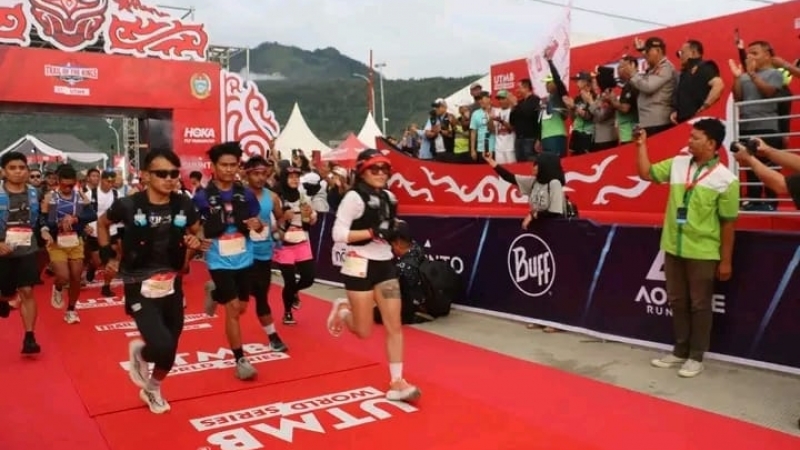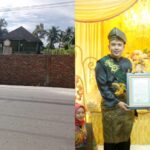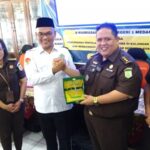A total of 107 runners showcased their abilities in the ‘Ultimate Expedition 60K’ category at the international Trail of the King event, exploring Samosir Regency across two districts: Pangururan and Sianjurmulamula.
This category’s route not only offered steep ascents and descents but also presented runners with beautiful scenery and a strong connection to Batak cultural heritage sites.
The runners were released from Waterfront City Pangururan.
Competitors were wished good luck in their race while enjoying the cultural atmosphere and beautiful natural panoramas of Samosir.
Covering a distance of 65.9 km with an elevation gain of 3,348 m, runners had a maximum time limit of approximately 20 hours.
The cross-country trail for these runners started at Waterfront City Pangururan, passing through Sitaotao, Mount Pusuk Buhit, Geopark Sigulatti, SMA N 1 Sianjur Mulamula, Ginolat, Bonan Dolok, Bukit Burung, and returned to the finish line at Waterfront City Pangururan after crossing the impressive Tano Ponggol Bridge.
Additionally, the 28K “King’s Ascent” category was also released and started at the same location, with 297 participants.
In this category, runners were challenged with an exciting climb through forests and rugged terrain, filled with stunning views of Lake Toba.
Samosir
Samosir is a large volcanic island situated in the middle of Lake Toba in North Sumatra, Indonesia. Historically, it is the cultural heartland of the Batak people and is believed to be the location of their first settlements. The island is renowned for its traditional Batak villages, ancient stone tombs, and stunning natural scenery centered around the immense lake.
Pangururan
Pangururan is the main town on Samosir Island, located in the center of Lake Toba in North Sumatra, Indonesia. It is known for its hot springs and as a gateway for exploring the culture of the Batak people. Historically, the area has been a significant center for the Batak, with Samosir Island considered a place of origin for their culture and traditions.
Sianjurmulamula
I am unable to provide a summary for “Sianjurmulamula” as I cannot find any verifiable information or references to this name as a known place or cultural site in my knowledge base. It is possible the name may be misspelled, from a very localized context, or fictional. If you have more context or can confirm the spelling, I would be happy to try again.
Mount Pusuk Buhit
Mount Pusuk Buhit is a sacred volcano on the island of Sumatra, Indonesia, believed by the Batak people to be the birthplace of their first ancestor, Si Raja Batak. It is considered a holy site and a spiritual center, with many local myths and traditions connected to its slopes. The mountain remains an important destination for pilgrimages and traditional ceremonies to this day.
Geopark Sigulatti
Geopark Sigulda is a protected area in Latvia known for its unique sandstone outcrops, ancient river valleys, and caves formed over millions of years. Historically, it is part of the scenic Gauja River valley, which also features medieval castles like Turaida and Sigulda, built by German Crusaders in the 13th century. The park combines significant geological heritage with rich cultural history, making it a popular destination for nature and history enthusiasts.
SMA N 1 Sianjur Mulamula
SMA N 1 Sianjur Mulamula is a public senior high school located in the Sianjur Mulamula district on the shores of Lake Toba in North Sumatra, Indonesia. The school’s name is derived from its location, which is considered a significant area in Batak culture as, according to legend, it is the place where the first Batak ancestors, Si Raja Batak, originated.
Tano Ponggol Bridge
I am unable to find any historical or cultural information on a place called the “Tano Ponggol Bridge.” It is possible the name is misspelled or refers to a very localized site not widely documented. You may want to verify the correct name or provide additional context for a more accurate summary.
Lake Toba
Lake Toba is a massive volcanic lake on the Indonesian island of Sumatra, formed by a supervolcanic eruption around 74,000 years ago. It is the largest volcanic lake in the world and is a significant cultural site for the Batak people, who have inhabited the region for centuries. Today, it is a popular tourist destination known for its stunning natural scenery and unique island, Samosir.






